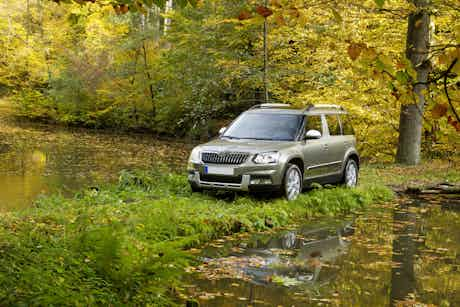Skoda Yeti and Yeti Outdoor – sizes and dimensions guide
April 13, 2015 by carwow staff

The Skoda Yeti is an undisputed gem within the automotive world. Since appearing in 2009, it has won countless awards stretching right across the board. As a result, it’s firmly established itself as one of the motoring elite.
Recently, the company decided to refresh the Yeti with a subtle facelift inside and out. Skoda also decided alongside this new facelifted version, it should launch a ‘spin-off’ model called the Yeti Outdoor. This added some underbody protection and some chunky plastic wheel arches.
If you’re looking to buy either version of the Yeti but aren’t sure if it’d be able to fit on your drive or in your garage, here’s a guide to help you with that decision.

Exterior dimensions
The Yeti is unlike most other cars on the road – even with its van like internal dimensions, it’s still roughly the same size on the outside as a normal family hatchback. The only catch is, to some, it doesn’t look as aesthetically pleasing as other rivals.
To put Yeti’s size into perspective, it’s shorter than both the Volkswagen Golf and Ford Focus but it’s slightly wider than both of them.
| Dimension | Skoda Yeti | Skoda Yeti Outdoor |
|---|---|---|
| Length | 4,222mm | 4,222mm |
| Width | 1,956mm | 1,956mm |
| Height | 1,671mm* | 1,691mm** |
| Wheelbase | 2,578mm | 2,578mm |
| Ground clearance | 180mm*** | 180mm*** |
*1,691mm on 2.0 TDI
**1,671mm on GreenLine II
***155mm on GreenLine II

Interior dimensions
Thanks to its van like silhouette, the interior is very spacious. Headroom is generous thanks to a tall roofline and, even with a short wheelbase, legroom is also commendable for all occupants.
The Yeti is wider than some rivals, so provides excellent levels of elbow and shoulder room. As a result, the cabin is more spacious than you’d find in the Suzuki S-Cross or Nissan Qashqai.

Luggage capacities
With the rear seats in place, the Yeti has 416 litres of boot space. That’s smaller than you get in the Nissan Qashqai but it’s larger than you’d get from all of the regular family hatchbacks. With the rear seats folded, the Yeti’s boot space rises to 1,580 litres and, if you take the rear seats completely out to create a van, the size of the boot increases to 1,760 litres.
Fuel tank capacities
The Yeti comes with a 55- or 60-litre fuel tank depending on what model you get. The 1.2-litre petrol engine, 1.6-litre diesel and 2.0-litre 108hp TDI with two-wheel drive get 55-litre tanks. The rest get 60-litre ones.
This means, across the line-up, the worst theoretical range comes from the 158hp, 1.8-litre petrol engine with four-wheel drive with a range of 488 miles. The highest theoretical range comes from the 104hp, 1.6-litre diesel with a manual gearbox and two-wheel drive which achieves 743 miles.

Towing weights
The maximum towing weight for the petrol engines ranges from 1,200kg for the 1.2-litre TSI to 1,800kg for the 1.8-litre TSI. The diesels are the better choice if you want to tow things. The 1.6-litre GreenLine TDI can tow a maximum of 1,400kg but the larger and more torquey 2.0-litre diesel can tow up to 2,100kg.
Weight and turning circle
The weight ranges from 1,259kg (1.2-litre TSI), to 1,565kg on the Yeti Outdoor (2.0-litre TDI) mated to the dual-clutch automatic gearbox and four-wheel drive.
When you specify the dual-clutch gearbox (DSG) in this car, the weight of the vehicle rises by 25kg. It rises further still when the four-wheel drive system is specified. This adds another 50kg to the vehicle’s weight.
The turning circles of both the Skoda Yeti and Yeti Outdoor work out at a reasonably compact 10.3 metres.

Are we there Yeti?
Read our full aggregated review of the Skoda Yeti and Yeti Outdoor. Head over to our car configurator to see how much you could save on one or, for more inspiration, head over to our deals page to see our latest discounts.















